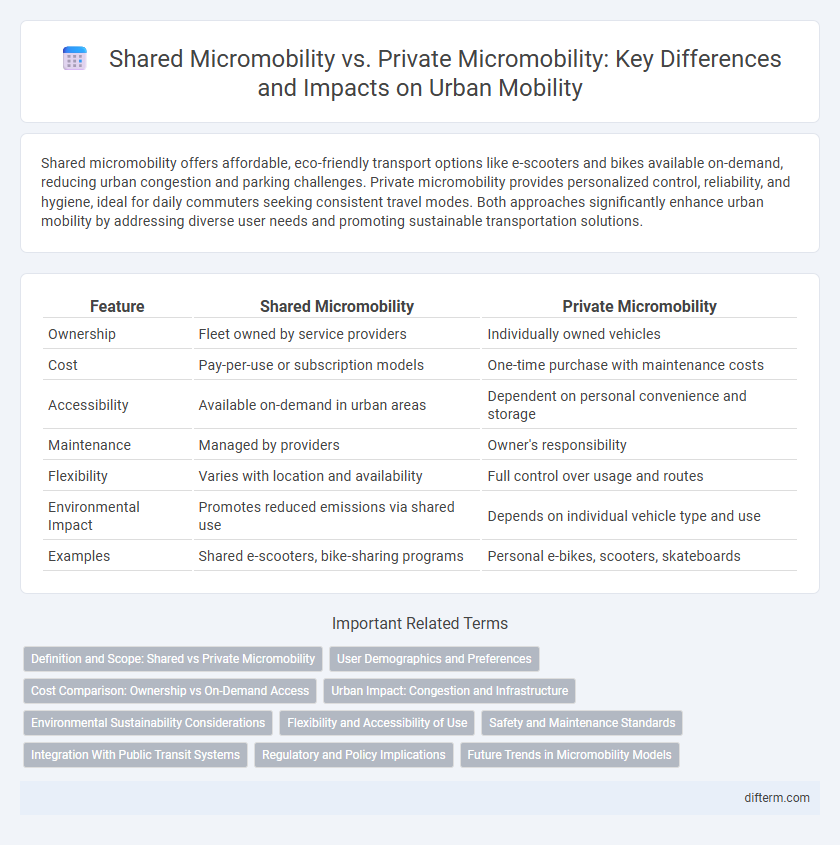Shared micromobility offers affordable, eco-friendly transport options like e-scooters and bikes available on-demand, reducing urban congestion and parking challenges. Private micromobility provides personalized control, reliability, and hygiene, ideal for daily commuters seeking consistent travel modes. Both approaches significantly enhance urban mobility by addressing diverse user needs and promoting sustainable transportation solutions.
Table of Comparison
| Feature | Shared Micromobility | Private Micromobility |
|---|---|---|
| Ownership | Fleet owned by service providers | Individually owned vehicles |
| Cost | Pay-per-use or subscription models | One-time purchase with maintenance costs |
| Accessibility | Available on-demand in urban areas | Dependent on personal convenience and storage |
| Maintenance | Managed by providers | Owner's responsibility |
| Flexibility | Varies with location and availability | Full control over usage and routes |
| Environmental Impact | Promotes reduced emissions via shared use | Depends on individual vehicle type and use |
| Examples | Shared e-scooters, bike-sharing programs | Personal e-bikes, scooters, skateboards |
Definition and Scope: Shared vs Private Micromobility
Shared micromobility refers to transportation modes such as e-scooters, bikes, and mopeds available for short-term rental through app-based platforms, designed for multiple users in urban environments. Private micromobility involves individuals owning personal electric bikes, scooters, or similar vehicles, used primarily for daily commutes or recreational purposes. The scope of shared micromobility emphasizes accessibility, reduced traffic congestion, and sustainability by promoting vehicle sharing, while private micromobility focuses on personal convenience, maintenance responsibility, and consistent availability.
User Demographics and Preferences
Shared micromobility services, such as e-scooters and bike-sharing programs, primarily attract younger urban residents aged 18-35 who prioritize affordability, convenience, and environmental impact in their travel choices. Private micromobility users tend to be more diverse in age, including professionals and suburban commuters who value personal ownership, reliability, and long-term cost savings. User preferences indicate a strong correlation between shared micromobility use and short, spontaneous trips within dense city areas, while private micromobility suits regular, longer commutes and those seeking greater control over their vehicle.
Cost Comparison: Ownership vs On-Demand Access
Shared micromobility significantly reduces upfront costs by eliminating the need for vehicle purchase, maintenance, and storage compared to private micromobility ownership. On-demand access models charge users per ride or time interval, offering budget-friendly alternatives in dense urban areas with fluctuating usage patterns. Private micromobility entails continual expenses such as insurance, repairs, and depreciation, making shared options more cost-effective for occasional riders.
Urban Impact: Congestion and Infrastructure
Shared micromobility significantly reduces urban congestion by promoting efficient vehicle use and lowering the demand for private car ownership, which alleviates traffic density and parking strain. Private micromobility, while offering personal convenience, often leads to increased infrastructure wear and limited space optimization due to inconsistent usage patterns. Urban planners benefit from integrating shared micromobility into transportation networks to enhance sustainable mobility and improve public space management.
Environmental Sustainability Considerations
Shared micromobility reduces carbon emissions by maximizing vehicle utilization and decreasing the need for private car trips, contributing significantly to urban air quality improvement. Private micromobility, while offering personal convenience, often results in higher resource consumption and lower overall sustainability due to underutilization and increased manufacturing demand. Life cycle assessments show shared e-scooters and bikes have a smaller environmental footprint compared to individually owned vehicles when integrated into multimodal transportation networks.
Flexibility and Accessibility of Use
Shared micromobility offers greater flexibility through on-demand access to scooters and bikes without the need for ownership or long-term commitment, enabling users to choose transportation based on immediate needs. Private micromobility provides consistent availability and control over the vehicle but limits spontaneous use to the owner's presence and maintenance schedule. Shared systems improve accessibility in urban areas by distributing vehicles widely, reducing barriers for users without personal storage or parking, while private options rely on individual capacity to store and maintain devices.
Safety and Maintenance Standards
Shared micromobility systems implement rigorous safety protocols and standardized maintenance schedules to ensure vehicle reliability and reduce accident risks. Private micromobility owners often face challenges adhering to consistent maintenance routines, potentially increasing safety hazards due to irregular inspections and repairs. Advanced safety features in shared fleets, coupled with professional upkeep, contribute to higher overall safety standards compared to privately owned micromobility devices.
Integration With Public Transit Systems
Shared micromobility services, such as e-scooters and bike-sharing programs, enhance urban mobility by providing first- and last-mile connectivity that seamlessly integrates with public transit systems. These shared options reduce the reliance on private vehicles and decrease congestion by offering flexible, on-demand transportation that complements buses, subways, and trains. Public transit authorities increasingly incorporate micromobility hubs and real-time data sharing to optimize route planning and improve multimodal trip experiences for commuters.
Regulatory and Policy Implications
Shared micromobility services require comprehensive regulatory frameworks to address safety standards, parking management, and equitable access, often involving city permits and operational caps. Private micromobility ownership faces fewer regulatory hurdles but raises policy concerns related to infrastructure usage, maintenance responsibilities, and integration with public transit systems. Effective policies balance innovation encouragement with public safety and urban mobility goals, promoting sustainable urban transport ecosystems.
Future Trends in Micromobility Models
Shared micromobility is poised for growth through integration with public transport systems, leveraging real-time data and AI for dynamic fleet management and enhanced user experience. Private micromobility continues to evolve with innovations in battery technology, vehicle design, and personalized smart features that boost safety and convenience. Future trends indicate a hybrid model blending shared and private benefits, supported by sustainable urban planning and regulatory frameworks promoting accessibility and environmental impact reduction.
Shared micromobility vs Private micromobility Infographic

 difterm.com
difterm.com